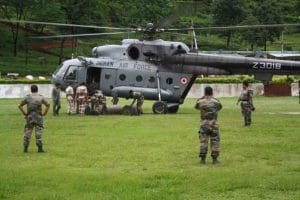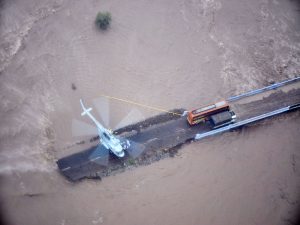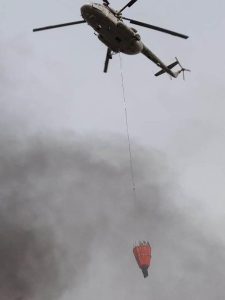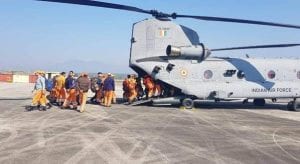Two Indian Air Force (IAF) C 130 J aircraft are in Jeddah to evacuate Indian nationals from Sudan. An IAF C 130 made a daring landing on a semi prepared, unlit airfield at night using night vision goggles (NVG) to evacuate stranded Indians from Wadi Sayyidna in Sudan. Forty-two IAF transport aircraft were deployed in Covid relief operations. On 27 February 2020, 76 Indians and 36 foreign nationals were evacuated from Wuhan (China). The aircraft had also carried medical supplies as a symbol of goodwill to China. “The IAF aircraft has landed. Mission completed. On to the next” was tweeted by External Affairs Minister S Jaishankar, when an IAF’s C-17 Globemaster brought back 58 Indians from Iran on 10 March 2020. Two IAF C-17s land in Turkey with supplies, and Indian Army medical personnel to set up a medical facility after last year’s earthquake. The role of the IAF has been distinctive in all kinds of operations because of its efficiency to respond fast along with its inherent characteristics of range, mobility and flexibility. [caption id=“attachment_12526002” align=“alignnone” width=“300”] Evacuation of Indians in Ukraine. Image: IAF[/caption] IAF’s Assets and HADR Response Capabilities Acquisition of Boeing C-17 Globemaster III (77.5-tonne load capacity) and Lockheed Martin C-130J-30 Super Hercules (20 tonne or 74 stretchers) to augment the existing fleet of Ilyushin Il-76 (40 tonne) and An-32 (6.7 tonne) aircraft has given IAF global reach and heavy-lift capability. C 130’s FLIR (Forward Looking Infrared) systems, night vision capability, and all-weather operations are a big asset. The aircraft’s optimised engine power, allows superior short-airfield performance. Boeing C-17 additional roles include medical evacuation and airdrop duties and aircraft has ability to operate from short and rough airstrips. It is ideal for mass casualty evacuation, VIP evacuation, nuclear contingencies etc. among many other roles. The EADS CASA C-295W will carry over 9 tonne. A large fleet of easily deployable Boeing CH-47 Chinook (10.8 tonne), Mi-8/17, and ALH and Chetak/Cheetah helicopters makes India a great regional player for disaster management. IAF’s Reconnaissance pods on fighter aircraft are also often used. [caption id=“attachment_12526022” align=“alignnone” width=“300”]
 Disaster Relief in Uttarakhand 2013. Image: IAF[/caption] The primary role of the Indian defence forces is to safeguard the nation’s sovereignty from external threats, but when called upon, they are equally proficient in performing Humanitarian Assistance and Disaster Relief (HADR) operations. IAF has its own emergency response teams co-located with major transport bases at Hindon, Palam, Bangalore, Guwahati and Chandigarh. It also has Rapid Aero Medical Teams (RAMT) positioned at vantage locations. All IAF bases have coordination with local Indian Army units and the National Disaster Relief Force (NDRF) battalions, all of which are manned by uniformed para-military personnel. In case of a disaster, rescue teams of NDRF and Indian Army can be dispatched quickly by IAF’s heavy-lift aircraft along with the required equipment and relief material. These aircraft can also evacuate people who are in urgent need of medical attention. The accessibility and a swift response through the air makes the IAF best suited to address certain critical situations. Other than countless rescue missions within the country, many nations have benefitted from the HADR and Non Combatant Evacuation (NCE) mission capabilities of the IAF. IAF’s Major HADR and NCE Operations The successful evacuation of 111,711 Indian citizens from Iraq, Kuwait and Jordan in 1990 by operating 488 flights over a period of 59 days by Air India and IAF was a world record. Similar missions were carried out from Lebanon in 2006 (Operation Sukoon) and in Libya in 2011. ‘Operation Neer’ was conducted to help Maldives in September 2014 which suffered a major drinking water crisis. IAF deployed three C-17 and three IL-76 flights to airlift 374 tonnes of drinking water to Male over the next two days. IAF deployed three C-17 aircraft in ‘Operation Rahat’ when civil war broke out in Yemen in 2015, and ferried back Indian nationals from Djibouti. 2,096 were flown out of the warzone in 11 evacuation flights. During the 2015 Nepal earthquake, IAF and Indian Army made 2223 sorties and rescued 11200 people. IAF was the first to reach the disaster hit Himalayan nation with Quick Response Teams (QRT). The world praised India for its “remarkable” response and described the country’s disaster management capabilities as sophisticated and advanced. [caption id=“attachment_12526042” align=“alignnone” width=“308”]
Disaster Relief in Uttarakhand 2013. Image: IAF[/caption] The primary role of the Indian defence forces is to safeguard the nation’s sovereignty from external threats, but when called upon, they are equally proficient in performing Humanitarian Assistance and Disaster Relief (HADR) operations. IAF has its own emergency response teams co-located with major transport bases at Hindon, Palam, Bangalore, Guwahati and Chandigarh. It also has Rapid Aero Medical Teams (RAMT) positioned at vantage locations. All IAF bases have coordination with local Indian Army units and the National Disaster Relief Force (NDRF) battalions, all of which are manned by uniformed para-military personnel. In case of a disaster, rescue teams of NDRF and Indian Army can be dispatched quickly by IAF’s heavy-lift aircraft along with the required equipment and relief material. These aircraft can also evacuate people who are in urgent need of medical attention. The accessibility and a swift response through the air makes the IAF best suited to address certain critical situations. Other than countless rescue missions within the country, many nations have benefitted from the HADR and Non Combatant Evacuation (NCE) mission capabilities of the IAF. IAF’s Major HADR and NCE Operations The successful evacuation of 111,711 Indian citizens from Iraq, Kuwait and Jordan in 1990 by operating 488 flights over a period of 59 days by Air India and IAF was a world record. Similar missions were carried out from Lebanon in 2006 (Operation Sukoon) and in Libya in 2011. ‘Operation Neer’ was conducted to help Maldives in September 2014 which suffered a major drinking water crisis. IAF deployed three C-17 and three IL-76 flights to airlift 374 tonnes of drinking water to Male over the next two days. IAF deployed three C-17 aircraft in ‘Operation Rahat’ when civil war broke out in Yemen in 2015, and ferried back Indian nationals from Djibouti. 2,096 were flown out of the warzone in 11 evacuation flights. During the 2015 Nepal earthquake, IAF and Indian Army made 2223 sorties and rescued 11200 people. IAF was the first to reach the disaster hit Himalayan nation with Quick Response Teams (QRT). The world praised India for its “remarkable” response and described the country’s disaster management capabilities as sophisticated and advanced. [caption id=“attachment_12526042” align=“alignnone” width=“308”] Flood Relief in Gujarat in 2015. Image: PRO MoD[/caption] India has come a long way since the Bhopal gas leak disaster of 1984, 1999 Orissa Cyclone, 2001 Bhuj Earthquake, December 2004 Tsunami, and Sikkim earthquake of September 2011, both in capability and response. India’s handling of the devastating Uttarakhand flood and Category 5 super cyclone Phailin in Orissa in 2013 also won international praise. That fact that in the 2013 Uttarakhand floods the IAF evacuated 23,892 people, delivered 798 tonnes of relief material and flew 3,536 missions in 65 days at the cost of losing one helicopter and entire crew on-board drives home the successful capabilities of HADR developed and employed by service. In January 2013, IAF helicopters aided Power Grid Corporation of India repair high tension lines, at about 10,000 feet above sea level, in the heavily snowbound Banihal area of Jammu and Kashmir. In August 2018, IAF used 24 choppers to rescue 1000s from flood-ravaged Kerala, flying 288 sorties under ‘Operation Karuna’. IAF had deployed 42 transport aircraft for Covid relief tasks including 12 heavy lift and 30 medium lift aircraft. They were used to bring in relief measures, personnel and material from abroad. They lifted huge empty Oxygen containers to industrial towns for filling and quick turnaround. IAF’s other HADR missions include airlifting civilians stuck in heavy snowfall; using helicopters with bambi-bucket to extinguish forest and urban fires; ropeway disaster rescues; and flood rescue and relief. Two Mi-17s and one Chinook helicopter were used to airlift Cheetahs that came from Namibia to Kuno National Park. In 2022, IAF flew 220 sorties in 2022 for meeting casualty evacuation demands of various state authorities. [caption id=“attachment_12526062” align=“alignnone” width=“307”]
Flood Relief in Gujarat in 2015. Image: PRO MoD[/caption] India has come a long way since the Bhopal gas leak disaster of 1984, 1999 Orissa Cyclone, 2001 Bhuj Earthquake, December 2004 Tsunami, and Sikkim earthquake of September 2011, both in capability and response. India’s handling of the devastating Uttarakhand flood and Category 5 super cyclone Phailin in Orissa in 2013 also won international praise. That fact that in the 2013 Uttarakhand floods the IAF evacuated 23,892 people, delivered 798 tonnes of relief material and flew 3,536 missions in 65 days at the cost of losing one helicopter and entire crew on-board drives home the successful capabilities of HADR developed and employed by service. In January 2013, IAF helicopters aided Power Grid Corporation of India repair high tension lines, at about 10,000 feet above sea level, in the heavily snowbound Banihal area of Jammu and Kashmir. In August 2018, IAF used 24 choppers to rescue 1000s from flood-ravaged Kerala, flying 288 sorties under ‘Operation Karuna’. IAF had deployed 42 transport aircraft for Covid relief tasks including 12 heavy lift and 30 medium lift aircraft. They were used to bring in relief measures, personnel and material from abroad. They lifted huge empty Oxygen containers to industrial towns for filling and quick turnaround. IAF’s other HADR missions include airlifting civilians stuck in heavy snowfall; using helicopters with bambi-bucket to extinguish forest and urban fires; ropeway disaster rescues; and flood rescue and relief. Two Mi-17s and one Chinook helicopter were used to airlift Cheetahs that came from Namibia to Kuno National Park. In 2022, IAF flew 220 sorties in 2022 for meeting casualty evacuation demands of various state authorities. [caption id=“attachment_12526062” align=“alignnone” width=“307”] Bambi-Bucket Operations. Image: IAF[/caption] Recovering IAF Airbases during Disaster During the 2001 Bhuj earthquake the runway at Bhuj airbase itself was badly damaged. IAF pilots landed on a partial runway to move critical repair equipment. Airbase was made fully operational in 48 hours and the follow up aerial rescue and relief won national praise. Similarly, during the 2004 Tsunami, at the southernmost airbase of the country at Car Nicobar Islands, IAF lost 116 personnel and families and the bulk of the airbase. The base was quickly recovered with the help of the Indian Navy and made operational. Emergency Management Disaster or Emergency management helps nations reduce vulnerabilities and cope with the aftermath, reducing mortality and economic loss from the disaster. Disaster could be caused by an act of terror, industrial accident, public disorder, natural calamity like earthquake, fire, cyclone etc. Ideally there is a need to anticipate potential risks and plan to reduce probability of occurrence. Often it still will occur and that would require a graded response. Disaster management is all about Readiness, Response, Reduction (Mitigation) and Recovery. The first stage is the incident location and gravity assessment so that action can be directed. An aerial survey is the fastest and best means to achieve this. Aircraft with specialised surveillance cameras, helicopters with observers, Unmanned Aerial Vehicles (UAV) with special day and night payloads are ideally suited for this. They will be able to instantly communicate the same through data transmission and through radio instructions. Stage II is delivery of initial men and materials for immediate rescue. Heavy equipment from far-flung areas and foreign lands is moved by large transport aircraft to nearest functional airports. Further, air movement could be through heavy/medium lift helicopters. Most critical equipment needed initially is to clear rubble to search for survivors and basic survival necessities like drinking water, food, first aid kits, tent age and blankets, emergency lights, and communication kits, including cell-phone chargers. After the immediate threat to human life has been handled starts the recovery stage. Aerial supplies through helicopters or fixed-wing aircraft drop to contain famine or epidemic is the next stage. Positioning doctors, medicines and food supplies are crucial. The air operations are speedier, allow flexibility, and are more scientifically executed. [caption id=“attachment_12526072” align=“alignnone” width=“322”]
Bambi-Bucket Operations. Image: IAF[/caption] Recovering IAF Airbases during Disaster During the 2001 Bhuj earthquake the runway at Bhuj airbase itself was badly damaged. IAF pilots landed on a partial runway to move critical repair equipment. Airbase was made fully operational in 48 hours and the follow up aerial rescue and relief won national praise. Similarly, during the 2004 Tsunami, at the southernmost airbase of the country at Car Nicobar Islands, IAF lost 116 personnel and families and the bulk of the airbase. The base was quickly recovered with the help of the Indian Navy and made operational. Emergency Management Disaster or Emergency management helps nations reduce vulnerabilities and cope with the aftermath, reducing mortality and economic loss from the disaster. Disaster could be caused by an act of terror, industrial accident, public disorder, natural calamity like earthquake, fire, cyclone etc. Ideally there is a need to anticipate potential risks and plan to reduce probability of occurrence. Often it still will occur and that would require a graded response. Disaster management is all about Readiness, Response, Reduction (Mitigation) and Recovery. The first stage is the incident location and gravity assessment so that action can be directed. An aerial survey is the fastest and best means to achieve this. Aircraft with specialised surveillance cameras, helicopters with observers, Unmanned Aerial Vehicles (UAV) with special day and night payloads are ideally suited for this. They will be able to instantly communicate the same through data transmission and through radio instructions. Stage II is delivery of initial men and materials for immediate rescue. Heavy equipment from far-flung areas and foreign lands is moved by large transport aircraft to nearest functional airports. Further, air movement could be through heavy/medium lift helicopters. Most critical equipment needed initially is to clear rubble to search for survivors and basic survival necessities like drinking water, food, first aid kits, tent age and blankets, emergency lights, and communication kits, including cell-phone chargers. After the immediate threat to human life has been handled starts the recovery stage. Aerial supplies through helicopters or fixed-wing aircraft drop to contain famine or epidemic is the next stage. Positioning doctors, medicines and food supplies are crucial. The air operations are speedier, allow flexibility, and are more scientifically executed. [caption id=“attachment_12526072” align=“alignnone” width=“322”] Chinook helicopter in a Rescue Mission. Image: IAF[/caption] Disaster Management in India Fifty-nine percent of India’s landmass is prone to earthquakes; 12 percent Indians are vulnerable to drought; 12 percent to floods; and 8 percent to cyclones. The Disaster Management Act of 2005 provides the blueprint for the National Disaster Management Authority (NDMA) and clearly specifies the roles of the Centre, state, and district authorities. On the basis of the act, on 1 June 2016, PM Narendra Modi, launched the Disaster Management Plan of India, which seeks to provide a framework and direction to government agencies. This is the first plan nationally since the enactment of the Disaster Management Act of 2005. The orientation was changed from relief-centric to a holistic approach involving diverse scientific, engineering, social, and financial processes, and encompasses prevention, mitigation, preparedness, response, relief, and rehabilitation. Due resource constraints, the state and the district levels invariably have to use military and central help. For earthquakes, tsunami, floods and cyclones, the Home Ministry is the nodal agency. Specific disasters are handled by specialised ministries, for example drought (Agriculture ministry), Nuclear (Atomic Energy), air accident (Civil Aviation), and rail by Railways. NDMA at the centre is chaired by the Prime Minister. Similarly, the State Disaster Management Authority (SDMA) is headed by the Chief Minister. The District Disaster Management Authority (DDMA) is headed by the District Commissioner who utilises the home guards and emergency fire services to support relief. Concurrently, the National Institute of Disaster Management (NIDM) at New Delhi focuses on human resource development, capacity building, training, research, documentation, and policy advocacy. At present, NDRF has a strength of 12 Battalions with each Battalion consisting of 1149 personnel, comprising 144 specialised teams who have been trained for various types of disasters. Four battalions are trained to handle radiological, nuclear, biological, and chemical disasters. Notwithstanding, the civil administration’s ability is inadequate. As a result, they rely on the armed forces for major emergency responses. Military the Ultimate Back Up Officially for disaster response, the military has a secondary role except in the case of chemical, biological, radiological and nuclear events. The Administrative Reforms Commission had recommended that the military should gradually be relieved from disaster handling roles. Discipline and efficiency is the first demand in disaster response and relief tasks, which are often dangerous missions, and the military invariably is in a position to bring order in post-disaster operations. The required wherewithal including the command, control and communication, are available with the field formations. Preparing for military operations other than war (MOOTW), of which disaster is the main component is a part of military training. At the national level, the Chief of the Integrated Defence Staff is a part of the National Executive Committee (NEC) of the NDMA. Challenges Ahead A tendency to over-rely on the military tends to stunt the initiative, responsibility and accountability of the civil officials. Through Operation Sadbhavana in Jammu and Kashmir armed forces were filling the vacuum in delivery and governance. Flouting norms of construction, ignoring drainage and flouting industrial safety norms, often with connivance of officials, are the cause of man-made disasters. Flood and cyclone prone areas are well known. Managing large religious gatherings should have been mastered by now. The civil administration needs to prepare for it. Increasing public awareness is important. Social media can be used for the same. Military leaders and troops need to be trained and updated on the various aspects of disasters. Large numbers of young ex-servicemen are also available for enrolment. Disaster management training should be encouraged in NCC and in colleges and other institutions. Air continues to be the fastest means to assess and deliver relief in any man-made and natural disaster. Modern technologies such as drones and robots should increasingly be used. Regular international exercises and defence cooperation are vital in achieving the desired level of efficiency during real time operations and HADR missions. The Ministry of External Affairs (MEA) should have IAF officers posted in a special division to ensure smooth conduct of overseas engagement of the IAF, which are increasing every year. Armed forces are proud of the fact that invariably they are the ‘first to enter and the last to leave’ a disaster site. The writer is Director General, Centre for Air Power Studies. Views expressed are personal. Read all the
Latest News ,
Trending News ,
Cricket News ,
Bollywood News , India News and
Entertainment News here. Follow us on
Facebook,
Twitter and
Instagram.
Chinook helicopter in a Rescue Mission. Image: IAF[/caption] Disaster Management in India Fifty-nine percent of India’s landmass is prone to earthquakes; 12 percent Indians are vulnerable to drought; 12 percent to floods; and 8 percent to cyclones. The Disaster Management Act of 2005 provides the blueprint for the National Disaster Management Authority (NDMA) and clearly specifies the roles of the Centre, state, and district authorities. On the basis of the act, on 1 June 2016, PM Narendra Modi, launched the Disaster Management Plan of India, which seeks to provide a framework and direction to government agencies. This is the first plan nationally since the enactment of the Disaster Management Act of 2005. The orientation was changed from relief-centric to a holistic approach involving diverse scientific, engineering, social, and financial processes, and encompasses prevention, mitigation, preparedness, response, relief, and rehabilitation. Due resource constraints, the state and the district levels invariably have to use military and central help. For earthquakes, tsunami, floods and cyclones, the Home Ministry is the nodal agency. Specific disasters are handled by specialised ministries, for example drought (Agriculture ministry), Nuclear (Atomic Energy), air accident (Civil Aviation), and rail by Railways. NDMA at the centre is chaired by the Prime Minister. Similarly, the State Disaster Management Authority (SDMA) is headed by the Chief Minister. The District Disaster Management Authority (DDMA) is headed by the District Commissioner who utilises the home guards and emergency fire services to support relief. Concurrently, the National Institute of Disaster Management (NIDM) at New Delhi focuses on human resource development, capacity building, training, research, documentation, and policy advocacy. At present, NDRF has a strength of 12 Battalions with each Battalion consisting of 1149 personnel, comprising 144 specialised teams who have been trained for various types of disasters. Four battalions are trained to handle radiological, nuclear, biological, and chemical disasters. Notwithstanding, the civil administration’s ability is inadequate. As a result, they rely on the armed forces for major emergency responses. Military the Ultimate Back Up Officially for disaster response, the military has a secondary role except in the case of chemical, biological, radiological and nuclear events. The Administrative Reforms Commission had recommended that the military should gradually be relieved from disaster handling roles. Discipline and efficiency is the first demand in disaster response and relief tasks, which are often dangerous missions, and the military invariably is in a position to bring order in post-disaster operations. The required wherewithal including the command, control and communication, are available with the field formations. Preparing for military operations other than war (MOOTW), of which disaster is the main component is a part of military training. At the national level, the Chief of the Integrated Defence Staff is a part of the National Executive Committee (NEC) of the NDMA. Challenges Ahead A tendency to over-rely on the military tends to stunt the initiative, responsibility and accountability of the civil officials. Through Operation Sadbhavana in Jammu and Kashmir armed forces were filling the vacuum in delivery and governance. Flouting norms of construction, ignoring drainage and flouting industrial safety norms, often with connivance of officials, are the cause of man-made disasters. Flood and cyclone prone areas are well known. Managing large religious gatherings should have been mastered by now. The civil administration needs to prepare for it. Increasing public awareness is important. Social media can be used for the same. Military leaders and troops need to be trained and updated on the various aspects of disasters. Large numbers of young ex-servicemen are also available for enrolment. Disaster management training should be encouraged in NCC and in colleges and other institutions. Air continues to be the fastest means to assess and deliver relief in any man-made and natural disaster. Modern technologies such as drones and robots should increasingly be used. Regular international exercises and defence cooperation are vital in achieving the desired level of efficiency during real time operations and HADR missions. The Ministry of External Affairs (MEA) should have IAF officers posted in a special division to ensure smooth conduct of overseas engagement of the IAF, which are increasing every year. Armed forces are proud of the fact that invariably they are the ‘first to enter and the last to leave’ a disaster site. The writer is Director General, Centre for Air Power Studies. Views expressed are personal. Read all the
Latest News ,
Trending News ,
Cricket News ,
Bollywood News , India News and
Entertainment News here. Follow us on
Facebook,
Twitter and
Instagram.
Air continues to be the fastest means to assess and deliver relief in any man-made or natural disaster
Advertisement
End of Article


)

)
)
)
)
)
)
)
)



